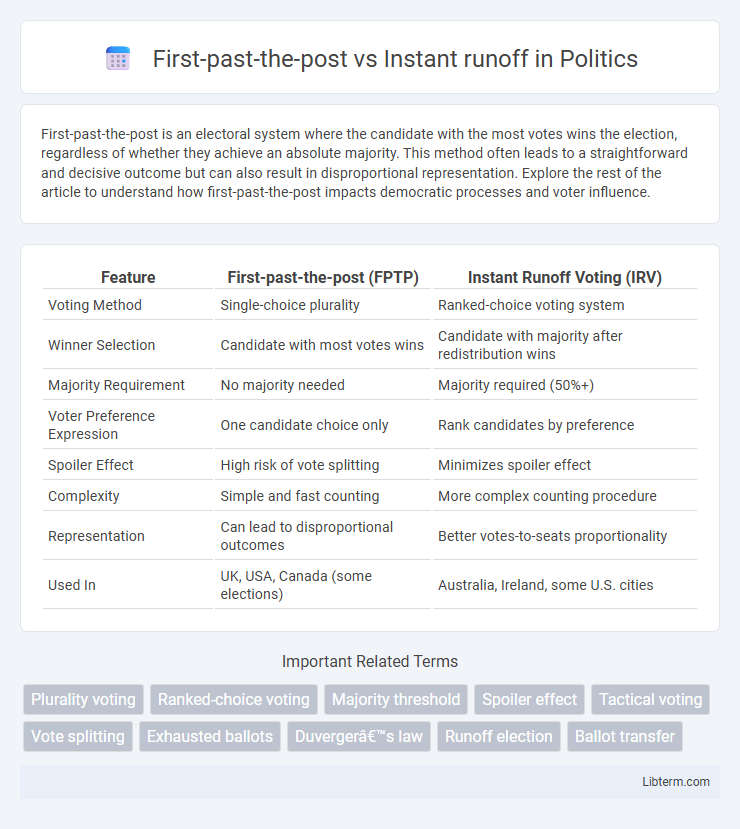First-past-the-post is an electoral system where the candidate with the most votes wins the election, regardless of whether they achieve an absolute majority. This method often leads to a straightforward and decisive outcome but can also result in disproportional representation. Explore the rest of the article to understand how first-past-the-post impacts democratic processes and voter influence.
Table of Comparison
| Feature | First-past-the-post (FPTP) | Instant Runoff Voting (IRV) |
|---|---|---|
| Voting Method | Single-choice plurality | Ranked-choice voting system |
| Winner Selection | Candidate with most votes wins | Candidate with majority after redistribution wins |
| Majority Requirement | No majority needed | Majority required (50%+) |
| Voter Preference Expression | One candidate choice only | Rank candidates by preference |
| Spoiler Effect | High risk of vote splitting | Minimizes spoiler effect |
| Complexity | Simple and fast counting | More complex counting procedure |
| Representation | Can lead to disproportional outcomes | Better votes-to-seats proportionality |
| Used In | UK, USA, Canada (some elections) | Australia, Ireland, some U.S. cities |
Understanding First-Past-the-Post (FPTP) Voting
First-Past-the-Post (FPTP) voting is a simple plurality system where the candidate with the most votes wins, regardless of whether they achieve an absolute majority. This system often leads to a two-party dominance and can result in the election of representatives who lack majority support from the electorate. While FPTP promotes decisiveness and simplicity, it can marginalize smaller parties and fail to reflect the full spectrum of voter preferences compared to Instant Runoff Voting (IRV).
Explaining Instant Runoff Voting (IRV)
Instant Runoff Voting (IRV) allows voters to rank candidates by preference, ensuring the winner has majority support without requiring multiple election rounds. If no candidate receives more than 50% of first-choice votes, the candidate with the fewest votes is eliminated, and their ballots are redistributed based on the second preferences. This process repeats until a candidate achieves a majority, promoting majority consensus and reducing the spoiler effect compared to First-past-the-post (FPTP) systems.
Key Differences Between FPTP and IRV
First-past-the-post (FPTP) is a plurality voting system where the candidate with the most votes wins, even without a majority, often leading to a two-party dominance and potential vote splitting. Instant runoff voting (IRV), also known as ranked-choice voting, requires voters to rank candidates by preference, ensuring the winner secures a majority through successive rounds of elimination and vote redistribution. Key differences include FPTP's simplicity and tendency to produce disproportional results, whereas IRV promotes majority support, reduces wasted votes, and encourages more diverse candidate participation.
Impact on Election Outcomes
First-past-the-post (FPTP) often leads to a two-party dominance, frequently resulting in majority governments that may not reflect the full spectrum of voter preferences. Instant runoff voting (IRV) enables voters to rank candidates, reducing the spoiler effect and increasing the likelihood of majority support for the winner. IRV tends to produce more representative outcomes by considering voter preferences more comprehensively, potentially minimizing strategic voting and enhancing voter satisfaction.
Voter Representation and Fairness
First-past-the-post (FPTP) often results in disproportionate voter representation by allowing candidates to win without a majority, potentially sidelining minority voices and skewing seat allocation relative to popular votes. Instant runoff voting (IRV) enhances fairness by enabling voters to rank candidates, ensuring winners have broader support and reducing the likelihood of "spoiler" effects in multi-candidate races. IRV better captures voter preferences, leading to outcomes that more accurately reflect the electorate's overall will compared to the often simplistic plurality outcomes of FPTP.
Effects on Political Parties and Candidates
First-past-the-post (FPTP) systems often favor larger, established political parties by marginalizing smaller parties and independent candidates, leading to a two-party dominance and reduced political diversity. Instant Runoff Voting (IRV) encourages broader candidate participation by allowing voters to rank preferences, which can empower smaller or third parties to gain traction without the fear of "wasting" votes. IRV reduces strategic voting and can lead to more moderate candidates as winners must appeal to a wider range of voters across their ranked preferences.
Simplicity and Voter Experience
First-past-the-post (FPTP) offers simplicity through straightforward voting and quick result tabulation, where the candidate with the most votes wins, minimizing voter confusion. Instant runoff voting (IRV) enhances voter experience by allowing ranked preferences, ensuring majority support and reducing wasted votes, though its complexity can challenge some voters during ballot marking and result understanding. Voters benefit from FPTP's ease of use but gain a more representative outcome with IRV's rank-choice system.
Potential for Tactical Voting
First-past-the-post (FPTP) voting often encourages tactical voting as voters may choose a less-preferred but more viable candidate to prevent an undesired outcome. Instant runoff voting (IRV) reduces the incentive for tactical voting by allowing voters to rank candidates, ensuring that votes are transferred and preferences are accurately reflected. This leads to more genuine voter expression and diminishes the spoiler effect commonly seen in FPTP systems.
International Examples and Case Studies
First-past-the-post (FPTP) systems, employed in countries like the United Kingdom, Canada, and India, often lead to majority governments but can marginalize smaller parties and reduce proportional representation. Instant runoff voting (IRV), used in Australia and recently in New York City elections, allows voters to rank candidates, promoting majority support and reducing the spoiler effect. Case studies from Australia reveal that IRV enhances voter satisfaction and representation, while FPTP examples from India demonstrate challenges in reflecting diverse electorates within parliamentary outcomes.
Choosing the Right Voting System
Choosing the right voting system depends on balancing simplicity, voter representation, and election outcomes. First-past-the-post (FPTP) offers straightforward counting and quick results but often leads to winner-takes-all outcomes that can marginalize minority voices. Instant runoff voting (IRV) enhances voter choice by allowing ranked preferences, reducing the spoiler effect and better reflecting majority support in single-winner elections.
First-past-the-post Infographic

 libterm.com
libterm.com